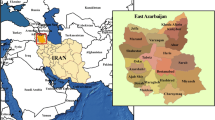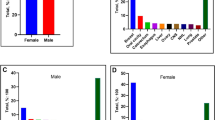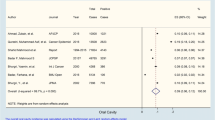Abstract
Northwest of Iran is a high-risk area with the highest annual incidence of cancers. Despite the growing epidemic of incidence of cancers, little information is available about that in the Kurdistan region. This was a cross-sectional epidemiological study during 2010–2015. The crude incidence rates (CRs) and age-standardized incidence rates (ASRs) were calculated per 100,000 people by different categories. Of 9218 patients, 5320 (57.71%) were male. The mean ages were 63.4 (± 21.43) and 55.8 (± 18.50) for male and female, respectively. The most common cancer (cases/100,000, percentage) among male gender was stomach cancer (24.23, 22%) and among female gender was breast cancer (18.38, 24%). Besides skin cancer, other most common cancers were bladder (12.33, 11%), colorectal (11.78, 11%), and esophageal (11.14, 10%) cancers in men. Esophageal (9.57, 13%), colorectal (8.68, 11%), and stomach (8.34, 11%) were the common cancers among women. The overall ASR of cancers was 94.98 and 131.99 per 100,000 among females and males. The standard sex ratio (male to female) was 1.39. Broadly applying effective prevention measures such as vaccination, use of early detection tests, awareness campaign, and lifestyle modifications could be adopted by local health authority for the reduction of such important public health priority.



Similar content being viewed by others
References
Fitzmaurice C, Dicker D, Pain A, Hamavid H, Moradi-Lakeh M, MacIntyre MF, et al. The global burden of cancer 2013. JAMA Oncology. 2015;1(4):505–27. https://doi.org/10.1001/jamaoncol.2015.0735.
Ferlay J, Soerjomataram I, Dikshit R, Eser S, Mathers C, Rebelo M, et al. Cancer incidence and mortality worldwide: sources, methods and major patterns in GLOBOCAN 2012. Int J Cancer. 2015;136(5):E359–86. https://doi.org/10.1002/ijc.29210.
Siegel RL, Miller KD, Jemal A. Cancer statistics, 2015. CA Cancer J Clin. 2015;65(1):5–29.
Siegel RL, Miller KD, Jemal A. Cancer statistics, 2016. CA Cancer J Clin. 2016;66(1):7–30.
World Health Organization. Noncommunicable diseases. WHO. 2014. http://www.who.int/nmh/countries/irn_en.pdf?ua=1. Accessed 1 Aug 2017.
Saatian M, Ahmadpoor J, Mohammadi Y, Mazloumi E. Epidemiology and Pattern of Traumatic Brain Injury in a Developing Country Regional Trauma Center. Bulletin of Emergency And Trauma. 2018;6(1 Jan):45–53.
Forouzanfar MH, Afshin A, Alexander LT, Anderson HR, Bhutta ZA, Biryukov S, et al. Global, regional, and national comparative risk assessment of 79 behavioural, environmental and occupational, and metabolic risks or clusters of risks, 1990–2015: a systematic analysis for the Global Burden of Disease Study 2015. Lancet. 2016;388(10053):1659–724.
Jenabi E, Poorolajal J. The effect of body mass index on endometrial cancer: a meta-analysis. Public Health. 2015;129(7):872–80.
World Health Organization. Cancer. WHO. 2017. http://www.who.int/mediacentre/factsheets/fs297/en/. Accessed 1 Aug 2017.
Ferlay J, Soerjomataram I, Dikshit R, Eser S, Mathers C, Rebelo M et al. Cancer incidence and mortality worldwide: sources, methods and major patterns in GLOBOCAN 2012. Int J Cancer. 2015;136(5).
Zendehdel K. Population-based cancer registry, IR of Iran. 2016. http://www.hbi.ir/research/sabt-bimariha/pbcrwslides/PBCR_IRAN_HIstory_and_Progress.pdf. 3, .
Etemadi A, Sadjadi A, Semnani S, Nouraie SM, Khademi H, Bahadori M. Cancer registry in Iran: a brief overview. Arch Iran Med. 2008;11(5):577–80.
Bray F, Jakob R. International Classification of Diseases for Oncology, 3rd Edition (ICD-O-3). Int Agency Res Cancer. 2000. http://who.int/classifications/icd/adaptations/oncology/en/. Accessed 3 Aug 2017.
Iran SCo. Census results Tehran. 2016. https://www.amar.org.ir/portals/0/census/1395/results/Census95_Jameiyat_Sen_Guruh.xlsx. Accessed 3 Aug 2017.
Iran SCo. National Population and Housing Census, 2011. Tehran2016. https://www.amar.org.ir/Portals/1/Iran/90.pdf. Accessed 3 Aug 2017.
United Nations. Population pyramids of the world from 1950 to 2100. Department of Economic and Social Affairs. 2017. https://www.populationpyramid.net/iran-islamic-republic-of/2017/. Accessed 11 Apr 2018.
Salehiniya H, Dashdebi SG, Rafiemanesh H, Mohammadian-Hafshejani A, Enayatrad M. Time trend analysis of cancer incidence in Caspian Sea, 2004–2009: a population-based cancer registries study (northern Iran). Caspian J Intern Med. 2016;7(1):25–30.
Amori N, Aghajani M, Asgarian F, Jazayeri M. Epidemiology and trend of common cancers in Iran (2004–2008). Eur J Cancer Care. 2016;26(5).
Torre LA, Siegel RL, Ward EM, Jemal A. Global cancer incidence and mortality rates and trends—an update. Cancer Epidemiol Prev Biomarkers. 2016;25(1):16–27.
Sadjadi A, Malekzadeh R, Derakhshan MH, Sepehr A, Nouraie M, Sotoudeh M, et al. Cancer occurrence in Ardabil: results of a population-based Cancer registry from Iran. Int J Cancer. 2003;107(1):113–8.
Mousavi SM, Gouya MM, Ramazani R, Davanlou M, Hajsadeghi N, Seddighi Z. Cancer incidence and mortality in Iran. Ann Oncol. 2009;20(3):556–63. https://doi.org/10.1093/annonc/mdn642.
Almasi Z, Rafiemanesh H, Salehiniya H. Epidemiology characteristics and trends of incidence and morphology of stomach cancer in Iran. Asian Pac J Cancer Prev. 2015;16(7):2757–61.
Somi MH, Mousavi SM, Naghashi S, Faramarzi E, Jafarabadi MA, Ghojazade M, et al. Is there any relationship between food habits in the last two decades and gastric cancer in North-Western Iran. Asian Pac J Cancer Prev. 2015;16(1):283–90.
Blaser MJ, Perez-Perez GI, Kleanthous H, Cover TL, Peek RM, Chyou P, et al. Infection with helicobacter pylori strains possessing cagA is associated with an increased risk of developing adenocarcinoma of the stomach. Cancer Res. 1995;55(10):2111–5.
Razi S, Enayatrad M, Mohammadian-Hafshejani A, Salehiniya H. The epidemiology of skin cancer and its trend in Iran. Int J Prev Med 2015;6.
Pakzad R, Ghoncheh M, Pournamdar Z, Pakzad I, Momenimovahed Z, Salehiniya H, et al. Spatial analysis of skin cancer incidence in Iran. Asian Pac J Cancer Prev: APJCP. 2015;17:33–7.
Song F, Qureshi AA, Gao X, Li T, Han J. Smoking and risk of skin cancer: a prospective analysis and a meta-analysis. Int J Epidemiol. 2012;41(6):1694–705. https://doi.org/10.1093/ije/dys146.
Whiteman DC, Pavan WJ, Bastian BC. The melanomas: a synthesis of epidemiological, clinical, histopathological, genetic, and biological aspects, supporting distinct subtypes, causal pathways, and cells of origin. Pigment Cell Melanoma Res. 2011;24(5):879–97.
Le Marchand L, Saltzman BS, Hankin JH, Wilkens LR, Franke AA, Morris SJ, et al. Sun exposure, diet, and melanoma in Hawaii Caucasians. Am J Epidemiol. 2006;164(3):232–45.
Ibiebele TI, van der Pols JC, Hughes MC, Marks GC, Williams GM, Green AC. Dietary pattern in association with squamous cell carcinoma of the skin: a prospective study. Am J Clin Nutr. 2007;85(5):1401–8.
Salimzadeh H, Bishehsari F, Sauvaget C, Amani M, Hamzehloo G, Nikfarjam A, et al. Feasibility of colon cancer screening by fecal immunochemical test in Iran. Arch Iran Med. 2017;20(12):726–33.
Quintero E, Castells A, Bujanda L, Cubiella J, Salas D, Lanas Á, et al. Colonoscopy versus fecal immunochemical testing in colorectal-cancer screening. N Engl J Med. 2012;366(8):697–706.
Wu A, Paganini-Hill A, Ross R, Henderson B. Alcohol, physical activity and other risk factors for colorectal cancer: a prospective study. Br J Cancer. 1987;55(6):687–94.
Winawer SJ, Fletcher RH, Miller L, Godlee F, Stolar M, Mulrow C, et al. Colorectal cancer screening: clinical guidelines and rationale. Gastroenterology. 1997;112(2):594–642.
Siegel R, Naishadham D, Jemal A. Cancer statistics, 2013. CA Cancer J Clin. 2013;63(1):11–30.
Jazayeri SB, Saadat S, Ramezani R, Kaviani A. Incidence of primary breast cancer in Iran: ten-year national cancer registry data report. Cancer Epidemiol. 2015;39(4):519–27. https://doi.org/10.1016/j.canep.2015.04.016.
Ghoncheh M, Mohammadian-Hafshejani A, Salehiniya H. Incidence and mortality of breast cancer and their relationship to development in Asia. Asian Pac J Cancer Prev. 2015;16(14):6081–7.
Eser S, Yakut C, Özdemir R, Karakilinç H, Özalan S, Marshall SF, et al. Cancer incidence rates in Turkey in 2006: a detailed registry based estimation. Asian Pac J Cancer Prev: APJCP. 2010;11(6):1731–9.
Bener A, Ayub H, Kakil R, Ibrahim W. Patterns of cancer incidence among the population of Qatar: a worldwide comparative study. Asian Pac J Cancer Prev. 2008;9(1):19–24.
Al-Hashimi M, Wang XJ. Breast cancer in Iraq, incidence trends from 2000-2009. Asian Pac J Cancer Prev: APJCP. 2014;15(1):281–6.
Kriege M, Brekelmans CT, Boetes C, Besnard PE, Zonderland HM, Obdeijn IM, et al. Efficacy of MRI and mammography for breast-cancer screening in women with a familial or genetic predisposition. N Engl J Med. 2004;351(5):427–37.
Savabi-Esfahani M, Taleghani F, Tabatabaeian M, Noroozi M, Lynge E. A qualitative exploration of personality factors in breast cancer screening behavior. Soc Behav Personal Int J. 2018;46(1):91–7.
Torre LA, Bray F, Siegel RL, Ferlay J, Lortet-Tieulent J, Jemal A. Global cancer statistics, 2012. CA Cancer J Clin. 2015;65(2):87–108.
Mohagheghi MA, Mosavi-Jarrahi A. Review of cancer registration and cancer data in Iran, a historical prospect. Asian Pac J Cancer Prev. 2010;11(4):1155–7.
Kmet J, Mahboubi E. Esophageal cancer in the Caspian littoral of Iran: initial studies. Science. 1972;175(4024):846–53.
Hormozdiari H, Day N, Aramesh B, Mahboubi E. Dietary factors and esophageal cancer in the Caspian Littoral of Iran. Cancer Res. 1975;35(11 Part 2):3493–8.
Islami F, Pourshams A, Nasrollahzadeh D, Kamangar F, Fahimi S, Shakeri R, et al. Tea drinking habits and oesophageal cancer in a high risk area in northern Iran: population based case-control study. BMJ. 2009;338:b929.
International Agency for Research on Cancer. Population Fact Sheets. GLOBOCAN. 2012. http://globocan.iarc.fr/Pages/fact_sheets_population.aspx. Accessed 1 Jul 2018.
The Kurdish Project. Kurdish Food. Fred Khosravi, San Francisco. 2018. https://thekurdishproject.org/history-and-culture/kurdish-culture/kurdish-food/. Accessed 30 Jun 2018.
Rübe CE, Fricke A, Widmann TA, Fürst T, Madry H, Pfreundschuh M, et al. Accumulation of DNA damage in hematopoietic stem and progenitor cells during human aging. PLoS One. 2011;6(3):e17487.
Chinen AB, Guan CM, Ferrer JR, Barnaby SN, Merkel TJ, Mirkin CA. Nanoparticle probes for the detection of cancer biomarkers, cells, and tissues by fluorescence. Chem Rev. 2015;115(19):10530–74.
Schembri E Are opioids effective in relieving neuropathic pain? SN Compr Clin Med 2018. https://doi.org/10.1007/s42399-018-0009-4.
Taylor DR. Single-dose fentanyl sublingual spray for breakthrough cancer pain. Clin Pharmacol: Adv Appl. 2013;5(24):131–41.
Asadi-Lari M Historical Background of the Ministry of Health in Iran. MOHME. 2015. http://ird.behdasht.gov.ir/page/http-c-o-l-o-n-ird.behdasht.gov.irportalribbon.aspx. Accessed 11 Apr 2018.
Acknowledgments
The authors thank the staff of Kurdistan Cancer Registry for their contribution towards this research work.
Author information
Authors and Affiliations
Corresponding author
Ethics declarations
Conflict of Interest
The authors declare that there is no conflict of interest to state.
Additional information
This article is part of the Topical Collection on Medicine
Rights and permissions
About this article
Cite this article
Hosseini, S.P., Fereidunian, A., Jamshidi, P. et al. Common Cancers Among Kurdish People in the Northwest of Iran: Current Status and Future Prospects. SN Compr. Clin. Med. 1, 215–223 (2019). https://doi.org/10.1007/s42399-018-0034-3
Accepted:
Published:
Issue Date:
DOI: https://doi.org/10.1007/s42399-018-0034-3




